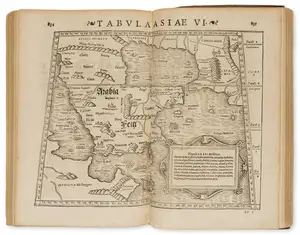Lot 182
Numismatics.- Budé (Guillaume) Libri V de Asse, bound by the Mendoza Binder, Venice, Heirs of Aldus Manutius and Andrea Torresano, 1522.
Hammer Price: £3,000
Description
Numismatics.- Budé (Guillaume) Libri V de Asse, collation: aa8, bb4, a-t8,u6, A-N8; [12], 262 [i.e. 260] ff., Aldine device on title and at end, blank space for capitals with printed guide letters, gutter and lower margin water-stained and spotted throughout, heavier at beginning and end, repairs to lower blank margin of title and final leaf, early shelfmark 'I.II.21' in ink on title, contemporary Venetian binding executed by Andrea di Lorenzo (the Mendoza Binder) of brown morocco over pasteboards, covers within blind and gilt fillet border, small Aldine leaves and rosettes at corners, central gilt panel of single fillet with cornerpieces and three tools in knotwork pattern, titled in gilt 'Guil. Budaei De Ass' at top, rebacked preserving original spine with three double raised bands alternating with three single bands, tooled in gilt, gilt gauffered edges, pastedowns and endpapers renewed, 4to (214x130 mm), Venice, Aldus Manutius's heirs and Andrea Torresano, September 1522.
⁂ The Aldine edition of the pioneering treatise by the antiquarian, and Royal secretary Guillaume Budé (1468-1540) in a fine contemporary binding by the Mendoza Binder. This is one of the earliest works devoted to the study of ancient coins and measures, and more generally to the economics of antiquity. The first edition of De Asse (the 'as' or pound is a Roman bronze coin) was published in March 1515 by Josse Bade in Paris, and the publication achieved a wide success, as evinced by its numerous editions and translations.
This copy is in a strictly contemporary morocco binding executed by Andrea di Lorenzo, called the 'Mendoza Binder'. There was a close relationship between this Venetian binder and the Manutius-Torresano partnership. Until c.1525 Andrea di Lorenzo seems to have mainly worked for the Anchor and Dolphin bookshop near the Rialto Bridge, decorating the bindings with characteristic features such as rectangular frames of fillets, rosettes, arabesque leaves, fleurons, and lozenges. For distinguished customers he added, at the head of the upper cover, the author and title in gilt lettering, or their names at the foot of the same cover.
Literature: Renouard, 94.3;Ahmanson-Murphy 212.
Description
Numismatics.- Budé (Guillaume) Libri V de Asse, collation: aa8, bb4, a-t8,u6, A-N8; [12], 262 [i.e. 260] ff., Aldine device on title and at end, blank space for capitals with printed guide letters, gutter and lower margin water-stained and spotted throughout, heavier at beginning and end, repairs to lower blank margin of title and final leaf, early shelfmark 'I.II.21' in ink on title, contemporary Venetian binding executed by Andrea di Lorenzo (the Mendoza Binder) of brown morocco over pasteboards, covers within blind and gilt fillet border, small Aldine leaves and rosettes at corners, central gilt panel of single fillet with cornerpieces and three tools in knotwork pattern, titled in gilt 'Guil. Budaei De Ass' at top, rebacked preserving original spine with three double raised bands alternating with three single bands, tooled in gilt, gilt gauffered edges, pastedowns and endpapers renewed, 4to (214x130 mm), Venice, Aldus Manutius's heirs and Andrea Torresano, September 1522.
⁂ The Aldine edition of the pioneering treatise by the antiquarian, and Royal secretary Guillaume Budé (1468-1540) in a fine contemporary binding by the Mendoza Binder. This is one of the earliest works devoted to the study of ancient coins and measures, and more generally to the economics of antiquity. The first edition of De Asse (the 'as' or pound is a Roman bronze coin) was published in March 1515 by Josse Bade in Paris, and the publication achieved a wide success, as evinced by its numerous editions and translations.
This copy is in a strictly contemporary morocco binding executed by Andrea di Lorenzo, called the 'Mendoza Binder'. There was a close relationship between this Venetian binder and the Manutius-Torresano partnership. Until c.1525 Andrea di Lorenzo seems to have mainly worked for the Anchor and Dolphin bookshop near the Rialto Bridge, decorating the bindings with characteristic features such as rectangular frames of fillets, rosettes, arabesque leaves, fleurons, and lozenges. For distinguished customers he added, at the head of the upper cover, the author and title in gilt lettering, or their names at the foot of the same cover.
Literature: Renouard, 94.3;Ahmanson-Murphy 212.







